BIO U2AOS1
5.0(1)
5.0(1)
Card Sorting
1/40
Study Analytics
Name | Mastery | Learn | Test | Matching | Spaced |
|---|
No study sessions yet.
41 Terms
1
New cards
Gene
\
DNA segment that codes for a trait, each having a particular position called a locus (loci). Determines characteristics.
DNA segment that codes for a trait, each having a particular position called a locus (loci). Determines characteristics.
2
New cards
Haploid
One chromosome set, 23 chromosomes. Includes gametes.
3
New cards
Diploid
Two chromosome sets, 46 chromosomes. Includes all body cells.
4
New cards
Polymers and Monomers
Polymer: Large molecule, long chain of small repeating units called monomers.
Monomers: small repeating molecules making up polymers.
Monomers: small repeating molecules making up polymers.
5
New cards
Nucleotide
made up of a phosphate, deoxyribose sugar, and one nitrogenous base.
6
New cards
Amino Acids
Adenine pairs with Thymine, and Guanine pairs with Cytosine.
7
New cards
DNA
deoxyribonucleic acid, the form in which all cells carry genetic information. It is a polymer made up of monomers called nucleotides.
8
New cards
Allele
\
Alternative form of a gene, one from each parent. Located at the same location on each chromosome, the locus.
Alternative form of a gene, one from each parent. Located at the same location on each chromosome, the locus.
9
New cards
Genome
sum total of an organism’s DNA. Measured in the number of base pairs contained in a haploid set of chromosomes.
10
New cards
Non-coding DNA
DNA that doesn’t have a particular function, called ‘junk DNA.’
11
New cards
Chromsomes
Structures containing a single DNA molecule and its associated proteins. They carry genes and determine characteristics. It is made of coiled and recoiled DNA.
12
New cards
Chromosomes in Prokaryotes
Singular circular chromosome. Contains plasmids and smaller DNA.
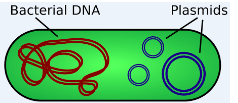
13
New cards
Chromosomes in Eukaryotes
Chromosomes are linear, located in the nucleus. DNA is wrapped around proteins called histones, allowing for condensing and packaging of DNA.
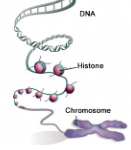
14
New cards
Centromere and Locations
Chromosomes split at the centromere, and the location can differ:
* **Metacentric**: centromere positioned in the middle
* **Submetacentric**: centromere positioned towards one end
* **Acrocentric**: centromere close to one end
* **Telocentric**: centromere close to the tip
* **Metacentric**: centromere positioned in the middle
* **Submetacentric**: centromere positioned towards one end
* **Acrocentric**: centromere close to one end
* **Telocentric**: centromere close to the tip
15
New cards
Chromosome sizes and Locus
**E**ach gene has a specific location on a chromosome called a locus. Sections of chromosomes called spacer DNA separate genes. Size can also depend on how many genes they contain.
16
New cards
Sex Chromosomes Male and Female
* Male: XY. Known as heterogametic. Sperm can carry either an X or Y chromosome.
* Female: XX, known as homogametic. Eggs carry an X chromosome.
* Female: XX, known as homogametic. Eggs carry an X chromosome.
17
New cards
Homologous Chromosomes
\
Of 46 chromosomes, 44 are matching pairs. The same gene is found at the same locus. Sex chromosomes in females are homologous (XX), whereas in males they are not (XY.)
Of 46 chromosomes, 44 are matching pairs. The same gene is found at the same locus. Sex chromosomes in females are homologous (XX), whereas in males they are not (XY.)
18
New cards
Karyotypes
\
Image of chromosomes taken during metaphase, when they’re most visible. Chromosomes are stained, becoming visible. Homologous chromosomes are paired together and therefore genetic abnormalities can be identified:
Image of chromosomes taken during metaphase, when they’re most visible. Chromosomes are stained, becoming visible. Homologous chromosomes are paired together and therefore genetic abnormalities can be identified:
19
New cards
Pedigrees
Used to study patterns of inheritance. Looks like a family tree with shapes.
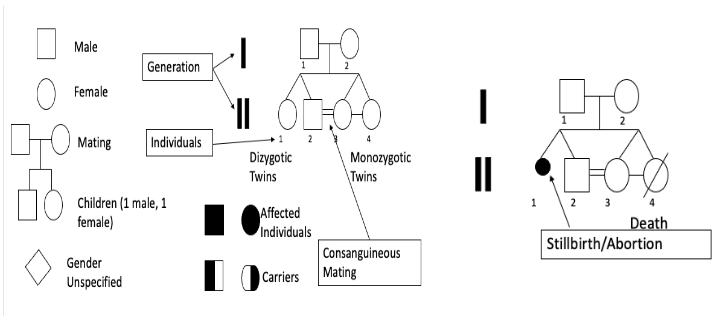
20
New cards
Autosomal recessive
both copies of the allele but be present to be expressed. Can skip a generation, not sex related
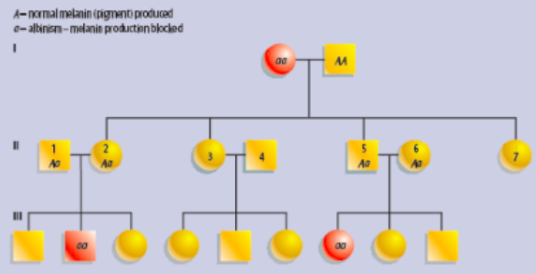
21
New cards
Autosomal Dominant
When at least one copy of the allele is present. Each affected individual has at least one parent with the trait. Not sex related and may be in every generation.
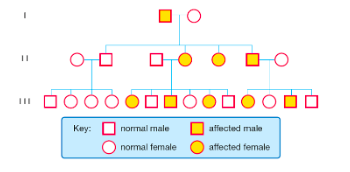
22
New cards
X-linked recessive
A female must be homozygous to exhibit the trait, males only need one copy of the allele to have the condition. If a female has the condition, so will her sons and father. Heterozygous females are carriers. Can skip a generation, more common in males.
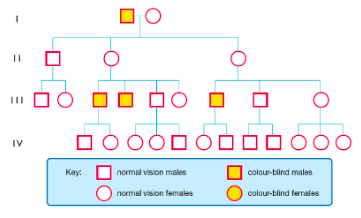
23
New cards
X-linked Dominant
More common in females, twice the chance of inheriting. Males always show the trait, as will heterozygous and homozygous females. Males with the trait will always pass to daughters, all affected sons will have an affected mother.
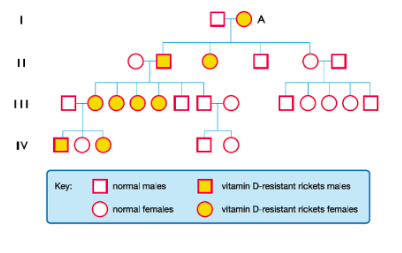
24
New cards
Y-Linked
Only present in males, affected fathers pass it on to all sons. Dominant and recessive do not apply, only one allele is inherited.
25
New cards
Somatic vs Body Cells
Somatic: All body cells.
Gametes: sex cells, given rise to by germline cells. Only receives half of the amount of genetic material, haploid, but after fertilisation it is restored to its full amount, diploid.
* Males: sperm, small in size and motile. Produce a larger number of gametes.
* Females: Ova, larger and not as many are produced.
Gametes: sex cells, given rise to by germline cells. Only receives half of the amount of genetic material, haploid, but after fertilisation it is restored to its full amount, diploid.
* Males: sperm, small in size and motile. Produce a larger number of gametes.
* Females: Ova, larger and not as many are produced.
26
New cards
Fertilisations
**W**hen two gametes of the male and female fuse, a sperm and an egg. This forms a single new cell called a zygote.
* A zygote is diploid for chromosomes, undergoing mitosis to develop into an embryo.
* A zygote is diploid for chromosomes, undergoing mitosis to develop into an embryo.
27
New cards
Crossing Over
Homologous chromosomes swap pieces, increasing variation in offspring. Variation is further increased by independent/random assortment. Maternal and paternal chromosomes line up and orient themselves randomly on the equator before division. Takes place for 23 pairs.
28
New cards
Meiosis: Phase 1 and Phase 2 Difference
Phase 1: Crossing over occurs. Two chromosomes are going through division rather than just the one.
Phase 2: One chromosome is separated into its chromatids, producing a total of 4 daughter cells
Phase 2: One chromosome is separated into its chromatids, producing a total of 4 daughter cells
29
New cards
Meiosis Phase 1 Stages:
* **Prophase I**: Homologous chromosomes match up and crossing over occurs.
* **Metaphase I:** Random assortment occurs, homologs line up on the equator. Nuclear membrane breaks down.
* **Anaphase I:** Each homologue separates and moves to opposite poles of the cell, being pulled by the spindle fibres.
* **Telophase I:** New nuclear membranes form and chromosomes decondense, cytoplasm divides (cytokinesis).
* **Metaphase I:** Random assortment occurs, homologs line up on the equator. Nuclear membrane breaks down.
* **Anaphase I:** Each homologue separates and moves to opposite poles of the cell, being pulled by the spindle fibres.
* **Telophase I:** New nuclear membranes form and chromosomes decondense, cytoplasm divides (cytokinesis).
30
New cards
Meiosis Phase 2 Stages:
__**Meiosis II:**__
* **Prophase II:** Nuclear membranes break down and chromosomes shorten and thicken. Centrioles move to poles and spindle fibres form.
* **Metaphase II:** Chromosomes line up along the equator, not in homologous pairs.
* **Anaphase II: E**ach sister chromatid is separated at the centromere, and they move to opposite poles of the cells.
* **Telophase II:** Nuclear membrane reforms and chromosomes uncoil and lengthen. Spindle disappears and nuclear envelopes reform. Cytoplasm divides in cytokinesis and 4 haploid daughter gametes are formed.
* **Prophase II:** Nuclear membranes break down and chromosomes shorten and thicken. Centrioles move to poles and spindle fibres form.
* **Metaphase II:** Chromosomes line up along the equator, not in homologous pairs.
* **Anaphase II: E**ach sister chromatid is separated at the centromere, and they move to opposite poles of the cells.
* **Telophase II:** Nuclear membrane reforms and chromosomes uncoil and lengthen. Spindle disappears and nuclear envelopes reform. Cytoplasm divides in cytokinesis and 4 haploid daughter gametes are formed.
31
New cards
Genotype
The set of alleles present in the DNA of an organism, result of inheritance.
* Dominant alleles: presented with a capital letter.
* Recessive alleles: presented with a lowercase letter.
* Dominant alleles: presented with a capital letter.
* Recessive alleles: presented with a lowercase letter.
32
New cards
Phenotype
Any distinct property/trait of an organism, physical, chemical, or physiological. Result of inherited alleles of genes as well as the influence of the environment.
* The environment can influence the phenotype of an organism regardless of its genotype. Identical genotype, different phenotype. For example:
* Hydrangeas change colour depending on soil pH.
* Himalayan rabbits have black fur on their limbs and ears to absorb the sun’s heat.
* The environment can influence the phenotype of an organism regardless of its genotype. Identical genotype, different phenotype. For example:
* Hydrangeas change colour depending on soil pH.
* Himalayan rabbits have black fur on their limbs and ears to absorb the sun’s heat.
33
New cards
Complete Dominance
When there are no inbetween traits.
* In blowflies, a single gene is enough to produce pigments in eye colour: WW Ww ww
* In blowflies, a single gene is enough to produce pigments in eye colour: WW Ww ww
34
New cards
Genetic Crosses: Ratios
* Genotypic ratios: ratio of different genotypes, eg. 2Yy:YY:yy
* Phenotypic ratios: ratio of different phenotypes, eg. 3 yellow: green
* Phenotypic ratios: ratio of different phenotypes, eg. 3 yellow: green
35
New cards
Monohybrid Crosses
The inheritance of a single characteristic. Uses a punnett square to determine genotype and phenotype:
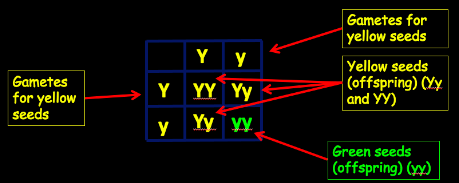
36
New cards
Dihybrid Crosses
The inheritance of two characteristics, alleles of two gene loci.
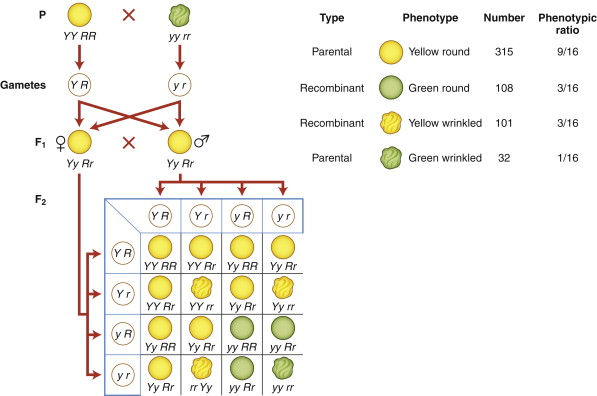
37
New cards
Polygenetic Inheritance: Continuous and Discontinuous Variation
**Polygenetic** traits have more than one gene that contributes to the phenotypes. This is known as **continuous variation**.
* For example, height is controlled by 50 different genes. The greater the number of genes, the more possible phenotypes.
**Discontinuous variation:** occurs when there are a few different alleles for one gene.
* Discrete variation is seen as a limited number of different phenotypes. Called a monogenetic trait, eg. blood system.
* For example, height is controlled by 50 different genes. The greater the number of genes, the more possible phenotypes.
**Discontinuous variation:** occurs when there are a few different alleles for one gene.
* Discrete variation is seen as a limited number of different phenotypes. Called a monogenetic trait, eg. blood system.
38
New cards
Epigenetics
Refers to changes to DNA structure that don’t alter the DNA sequence. Epigenetic marks result in gene expression changes, and therefore phenotypes.
39
New cards
Test Crosses
A phenotype cannot always show a genotype. To find genotype, an individual is bred with a homozygous recessive individual. It is to determine an individuals unknown genotype.
* Homozygous recessive only produces recessive alleles, so the phenotype will show the parent’s unknown genotype.
* Homozygous recessive only produces recessive alleles, so the phenotype will show the parent’s unknown genotype.
40
New cards
Codominance
Full phenotypic expression of both alleles is observed. Not showing simple dominance or recessiveness. Both alleles are expressed in the phenotype of heterozygous individuals.
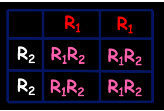
41
New cards
Linked Genes
Linkage is the tendency for two or more genes located on the same chromosome to be inherited together.
* The closer the genes are the more likely they are to be linked.
* Examples of linked genes: freckles, red hair, blue eyes.
* The closer the genes are the more likely they are to be linked.
* Examples of linked genes: freckles, red hair, blue eyes.